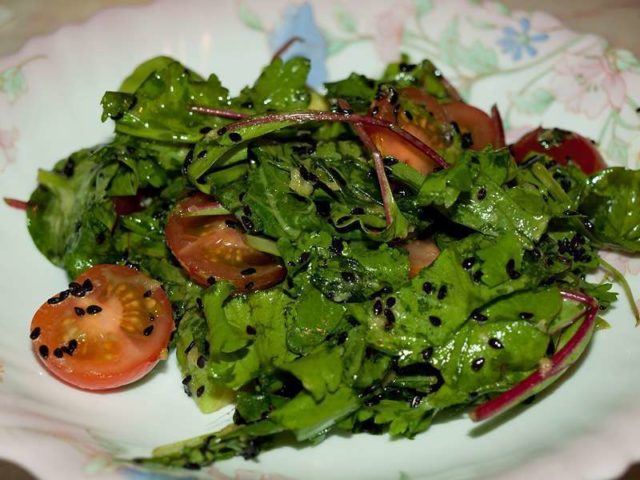Content
Japanese cabbage Mermaid is a cold-resistant salad variety that can be grown in open ground. The leaves have a pleasant taste with a slight mustard aftertaste; they are used for preparing cold appetizers, salads and first courses.
Description of Japanese cabbage Little Mermaid
Japanese Mermaid cabbage has feathery foliage with serrated edges. From 40 to 60 leaves are formed in the rosette, the height of which varies between 30-40 cm. The surface is smooth, but wrinkles may be observed. The foliage color is green with a thin white vein. The taste is delicate, pleasant, without strong bitterness, the aroma is faintly perceptible.

Japanese cabbage variety is resistant to adverse weather conditions
The culture tolerates cold weather well and does not suffer from extreme heat. The harvest can be harvested within two months after planting.
Advantages and disadvantages
When choosing crops to grow, be sure to pay attention to their advantages and disadvantages. The Japanese cabbage Mermaid has a lot of advantages:
- resistance to sudden changes in weather, seedlings are not afraid of falling and rising temperatures;
- good taste without bitterness, which allows it to be used as food for people suffering from gastritis, gastrointestinal diseases and heart pathologies;
- versatility. Not only salads are prepared from cabbage, it is added to hot dishes and also covered for the winter;
- its beautiful appearance allows this variety to be grown as a decorative element on an alpine hill;
- high yield.
The disadvantages of vegetable growers include the fact that Japanese cabbage is susceptible to attack by the cruciferous flea beetle. In addition, cabbage is moisture-loving, so it cannot be done without watering.
Yield of Japanese cabbage "Little Mermaid"
The mass of cabbage is about 1.2 kg, but there are also large specimens whose weight is close to 1.7 kg. When planting 4 seedlings per 1 sq.m, you can collect about 5-6 kg of foliage with petioles.
Planting and caring for Japanese cabbage "The Little Mermaid"
Japanese cabbage prefers medium loamy, well-drained soil. To get a high yield, you need to follow simple planting and care rules.
The beds are chosen in a well-lit area, because the Japanese cabbage Mermaid needs a sufficient amount of ultraviolet radiation. Soil preparation is carried out in the fall.

The soil is dug up, weeds and old roots are removed, and also fertilized with humus.
In early spring, ammonium nitrate is scattered on the site at the rate of 15-20 g per 1 m². If the soil is highly acidic, liming is carried out.
Seeds can be sown in a greenhouse for forcing seedlings or directly into open ground.
If you decide to do without growing seedlings of Japanese cabbage Mermaid, sowing seeds begins in mid-April. The plant sprouts even in cold weather, when the air temperature does not exceed +4 °C. Japanese culture is not afraid of spring frosts.It can withstand short-term temperature drops down to -4°C. Favorable conditions for the growth of cabbage in open ground are considered to be warm and rainy weather with temperatures from 16 to 26 °C. Excessively high temperatures and lack of moisture can cause sunburn on the foliage.

A weak solution of potassium permanganate is used to disinfect seeds and treat soil
In early or mid-March, planting material is pickled in manganese, soaked in warm water and planted in peat cups. In greenhouse conditions they will germinate on the third day. Transplantation into open ground begins in early May.
Some gardeners practice sowing seeds before winter. The procedure is carried out before the onset of stable cold weather, but the air temperature should be close to zero. If there is a thaw after sowing, the seeds will sprout, but will not survive the winter. The approximate planting date is the end of October or November. It all depends on the weather conditions of the region. Because not all seeds will be able to survive until spring; they are sown 2-3 times more than would be planned for spring planting.
For the autumn procedure, choose an elevated area, which will warm up and dry most quickly in the spring. The seeds are poured into the furrows, sprinkled with dry soil, and mulched on top with leaves or hay. There is no need to water the garden bed.
Care consists of regular watering. Cabbage loves moisture, but excessive stagnation of water negatively affects its condition. Due to waterlogging, the roots may rot and the seedlings will disappear.In addition to watering, the crop requires weeding to remove weeds, which is carried out as they appear, as well as loosening the rows.
Japanese Mermaid cabbage is capable of accumulating nitrates in the foliage, so fertilizers can be applied to a minimum. Fertilizing done in the fall and early spring, even before planting the seedlings in the ground, is sufficient.
If the soil is depleted, you can feed the Mermaid cabbage with a potassium-phosphorus mixture.
Diseases and pests
To prevent the development of diseases on Japanese Mermaid cabbage, it is necessary to observe crop rotation. Good predecessors for the crop will be legumes, pumpkin and nightshade plants. It is not recommended to plant a Japanese variety after cruciferous vegetables, since they have common diseases and pests.
Blackleg
It appears mainly on young seedlings in the form of darkened and dry areas at the bottom of the shoots.

To prevent blackleg, pre-planting seed treatment with Bactofit is recommended.
When a disease is detected, damaged leaves are removed, and the plant is watered at the root with a weak solution of manganese.
Downy mildew
Appears as an off-white coating on the foliage, and yellow spots can also be seen. Not only young, but also adult specimens can get sick. Prevention consists of proper planting and care: the soil should not be thickened or over-moistened.

When the first symptoms of peronosporosis appear, Mermaid cabbage seedlings are sprayed with Bordeaux mixture or fungicides
Fomoz
The first signs are spots and a dark root collar. Young seedlings are susceptible to disease.If detected, it is necessary to spray with Bordeaux mixture (1% solution).

For preventive purposes, treat the soil with a solution of potassium permanganate.
Pests can also reduce yields.

Cruciferous flea beetle loves Japanese cabbage The Little Mermaid
You can notice the appearance of insects by small holes on the shoots and foliage. The pest invasion is observed in the spring, when the air temperature warms up to +16-17 °C.
You can fight cruciferous flea beetle in various ways. Insects do not like high humidity, so regular watering will prevent them from appearing. Dusting plants with tobacco and ash is effective; lime can be used instead of tobacco dust.
You can dust not only the seedlings, but also the ground. To do this, it is recommended to use naphthalene or tobacco dust. You can also spray the plants and area with a mixture of laundry soap and ash. For 0.5 liters of hot water you will need 2 tbsp. l. ash and 20 g of soap shavings.
The cruciferous flea flea does not tolerate the smell of garlic, so spraying can be done with garlic infusion. You can use crushed tomato tops and green soap to create a spray mixture.
A weak vinegar solution will also repel uninvited insects. To prepare it, use 9% vinegar (250 ml) and warm water (10 l).
Application
Japanese Mermaid cabbage is edible both fresh and processed.

The tops are recommended for use in preparing salads, cold and hot appetizers, sandwiches, soups, borscht, and vegetable stews.
The leaves are added to marinades, as well as pickles and other winter preparations.
The pleasant peppery aroma of the Little Mermaid allows you to use cabbage leaves as an addition to meat and fish dishes.When fresh, the foliage is active in creating cheese sandwiches.
Japanese cabbage Mermaid is not only tasty, but also healthy. It contains carotene and a number of vitamins - C, B1 and B2, PP. Due to its high iron content, cabbage is recommended for the prevention of anemia. Calcium and potassium salts, as well as phosphorus, included in the tops of the crop, are necessary for people suffering from cardiovascular diseases.
Conclusion
Japanese cabbage Mermaid is suitable for growing both in open ground and in a greenhouse. Decorative foliage contributes to the fact that the crop is grown in flower beds and alpine hills.








